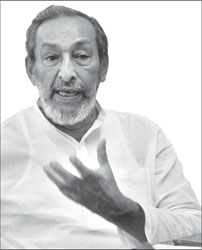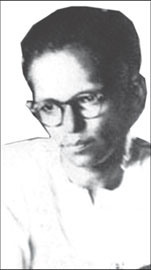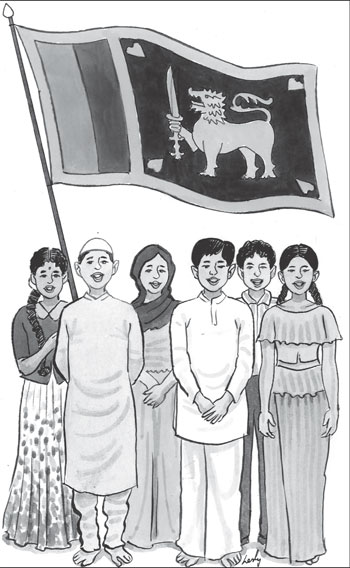Vasu, DO NOT KILL Ananda Samarakoon again
Jinadasa Bamunuarachchi
In December 2010, it was reported that the Cabinet of Sri Lanka
headed by President Mahinda Rajapaksa had taken a decision to scrap the
Tamil translation of Sri Lanka Matha at official and state functions, as
“in no other country was the national anthem used in more than one
language” - even though the national anthems of Canada, South Africa and
those of several other countries have more than one language version.
|

Minister Vasudewa Nanayakkara |
The Cabinet’s decision had followed a paper on the national flag and
national anthem presented by the Minister of Home Affairs W. D. J.
Senewiratne. The paper had drawn on the Singaporean model where the
national anthem is sung in the official lyrics and not any translation
of the lyrics. Based on this principle, the paper recommended that the
Sri Lankan national anthem only be sung in Sinhala and the Tamil
translation be abolished. This was exactly the right thing to do and it
has been done in keeping with the constitutional status of the National
Anthem of Sri Lanka.
Media reported last week that Vasudewa Nanayakkara has sought
presidential sanction to sing the national anthem of Sri Lanka in the
Tamil language or to do a Tamil version of it in view of the
65thIndependence Day celebrations to be held in the Eastern Province. (I
really do not know what he is trying to do) May be Vasudewa has no
useful job to do and is trying to score a point by creating an unwanted
and unwarranted issue at this point of time when the unified country is
making headway to stand on its feet.
Furthermore, he may be trying to make it look like an attractive
proposition which may not harmful per se but when taken with other
factors and empirical evidence his proposition is suicidal as we are
passing a critical moment in our country’s history.
Indian National anthem
Minister Wimal Weerawansa once taking part at a talk show programme
on a private Channel described the Tamil version a ‘mistake’ and had
cited India as an analogy.
Some critics were critical that it was wrong of Weerawansa to cite
India as an analogy because according to them the Indian national anthem
was not in Hindi, which is the most widely spoken language of India, but
in Bengali, a minority language. This is wrong and Weerawansa is
correct. Indeed, according to official Government of India website, the
Indian National anthem was not adopted in its Hindi version.
The proceedings of the Constituent Assembly of India on 24 January
1950 do not mention that the National Anthem was ‘adopted’, nor does it
mention that it was done so in its Hindi version. It is a fact that
Indian national Anthem whose lyrics are vastly Sanskritized going by the
great Indian tradition of writing epics in Sanskrit language.
As is known to everybody, the National Anthem of Sri Lanka was
written and composed by Ananda Samarakoon in 1940, and was later adopted
as the National Anthem of Sri Lanka.
|

Ananda Samarakoon |
The song became famous after a 50 member choir from Museaus College,
Colombo sang it on a public occasion. It was also broadcast on Radio
frequently. ‘Namo Namo Matha’ though without official recognition was
now becoming popular as a ‘de-facto’ national anthem.
It was written when Sri Lanka was still a British colony and was
initially written as a tribute to Sri Lanka, expressing sentiments of
freedom, unity and independence, and not for the purpose of serving as a
national anthem.
The song however became very popular throughout the 1940s and when
Sri Lanka gained independence in 1948 it was chosen to be the national
anthem, three years later. It was sung, at the Independence Day in 1952.
Ananda Samarakoon was Rabindranath Tagore’s student and the tune is
influenced by Tagore’s genre of music.
Cabinet paper
The song was officially adopted as the national anthem of Ceylon on
November 22, 1951, by a committee headed by Sir Edwin Wijeyeratne. The
anthem was translated into the Tamil language by M. Nallathamby.
In 1950, the then Finance Minister JR Jayewardene presented a Cabinet
Memorandum that the widely popular ‘Namo Namo Matha’ be formally
acknowledged as the official anthem.
Prime Minister DS Senanayake set up a select committee under the Home
Affairs and Rural Development Minister Sir EAP Wijeratne to finalise the
issue.
The committee headed by Wijeratne considered ‘Namo Namo Matha’ and
some other lyrics and decided that Samarakoon’s ‘Namo Namo Matha’ should
be the national anthem.
There was however a minor hitch. The committee wanted a minor change
in the words. Samarakoon was then in India and after he returned home in
mid 1951, Ananda Samarakoon was invited to discuss the matter with Sir
Edwin AP Wijeratne.
The song had originally been composed when the country was under the
British. Now it was independent. It was therefore felt that the 10th
line in the song was inappropriate and had to be changed. Samarakoon
agreed to change the line. He amended the lines as follows.
‘Nawajeewana Damine’ was changed to ‘Nawa Jeewana Demine Nithina
Apapupudu Karan Matha’ with the wholehearted consent and approval of
Ananda Samarakoon who was prone to reality.
Sir EAP Wijeratne then presented a Cabinet paper in August 1951
recommending ‘Namo Namo Matha’ as the national anthem of Ceylon. It was
unanimously approved by Cabinet and formally adopted on November 22,
1951.
 There were two Tamil Ministers in the DS Senanayake Cabinet then.
They were GG Ponnambalam and C. Sittambalam. They concurred with the
need and their consent and approval was readily given. There were two Tamil Ministers in the DS Senanayake Cabinet then.
They were GG Ponnambalam and C. Sittambalam. They concurred with the
need and their consent and approval was readily given.
While Namo Namo Matha was now being sung as the official anthem there
was no uniformity in the melody or manner of singing. Different choirs
and singers were rendering it in different ways.
Government therefore appointed an eleven member committee in 1953 to
ensure that uniformity was ensured in rendering the national anthem.
Among its members were Ananda Samarakoon himself.
This committee set out guidelines as to how the anthem should be sung
and also defined the exact tune for it. The melody was a refined version
of the original tune composed by Samarakoon. Cargills then agents for
HMV records was given the order to make vinyl.
On June 24, 1954 the Cabinet of Sir John Kotelawela formally endorsed
the tune and singing of the National Anthem. The copyright ownership of
‘Namo Namo Matha’ was formally acquired by the government after payment
of Rupees 2,500 on that day. The money however did not go to Ananda
Samarakoon as he had already transferred copyright to Siriwardena the
printing press owner who had first published the song in a book of
poems.
Arbitrary action
Ananda Samarakoon did not care about money. His song was officially
recognized as the National Anthem of a nation whose history dates back
to 2500 years. He accomplished a mission for the nation, no other person
had done.
During the latter part of 1958 there emerged a notion that the
notations in ‘Namo Namo Matha’ were not suitable in line with the ‘gana.’
The letter ‘Na’ at the beginning was described as a malefix. The
inauspicious ‘Gana’ at the beginning of the national anthem was said to
be unacceptable.
A ‘gana’ is the placing of the first three syllables – how the long
and short syllables occur. The opening words of the anthem ‘na-mo-na’
short-long-short constituted an unacceptable ‘gana’, it was alleged.
As criticism mounted Ananda Samarakoon was constrained to defend
himself against the charges. He engaged in many newspaper debates and
also spoke at public meetings in defence of ‘Namo Namo Matha’.
Mrs. Bandaranike came to power in 1960 and her government decided to
amend the National Anthem and a committee was appointed to examine the
issue and determine whether the national anthem should be amended as her
advisers claimed.
The committee recommended that the words ‘Namo Namo Matha’ be changed
to ‘Sri Lanka Matha’. Ananda Samarakoon protested strongly and opposed
the proposed change. The government however went ahead and unilaterally
amended the national anthem from ‘Namo Namo Matha’ to ‘Sri Lanka Matha’
in February 1961.
Ananda Samarakoon’s consent was not obtained. Since copyright was now
vested with the government, there was no legal remedy available for the
poet to prevent this arbitrary action. This caused immense distress and
had a debilitating effect on the poet who was side-lined for unknown
reason. His views should have been consulted. But this did not happen in
this case.
Official version
On April 5, 1962 Ananda Samarakoon was found dead.. His door was
broken open as he was not answering knocks on his door. The inquest
revealed that he had died of an overdose of sleeping tablets. There was
a letter on his desk to then Opposition Leader Dudley Senanayake
complaining of how his anthem had been mutilated. There was also a
serene painting on his easel of the Buddha meditating and a deer looking
on.
The remarkable nature and attribute of Sri Lanka’s national anthem is
that it sings paeans of patriotic praise to the country alone and not to
any race or religion.
It is not parochial. It unifies the nation. It does not need any
Tamil or English treatment. Leave it alone. Do not kill the great poet
for the second time.
I remember in 2003 when I was working at ANCL, (Lake House) an
attempt was made to orchestrate the National Anthem in a more cogent
manner by a very competent band of singers. This idea was mooted by
Bandula Padmakumara who was a director of ANCL at the time. The reason
for suggesting this was this. The current official version of national
anthem has been very old and sung with oriental music only.
The idea was to render the national anthem in a more advanced
technological environment. This programme was titled ‘jathika geeyata
anuprane’ by Tilakaratna Kuruvitabandara, Editor of Silumina at the
time. There was absolutely no change.
The proposal was only orchestrating more prudently using a
professional choir and issuing an official version. This programme had
to be abandoned due to objections from various quarters.
National anthem belongs to the nation and it has a national
character. Each race in the country cannot have separate lyrics in their
language. Vasu’s attempt in this backdrop appears to be very much
counterproductive.
There are many forces nationally and internationally that are unhappy
about crushing the Tigers militarily to end the war. One would only
encourage such forces by making attempts of this nature. Undoubtedly
this proposition if any has been made without careful judgement of the
pros and cons that would flow from this decision.
There are much more important pressing problems currently affecting
our country than messing up the national anthem. Pristine glory of
nawavamansika is gone in the wind my dear comrade. This proposal of Vasu
does not mean to serve the national interest of our country but would
help serve the expectations of the LTTE rump. |







